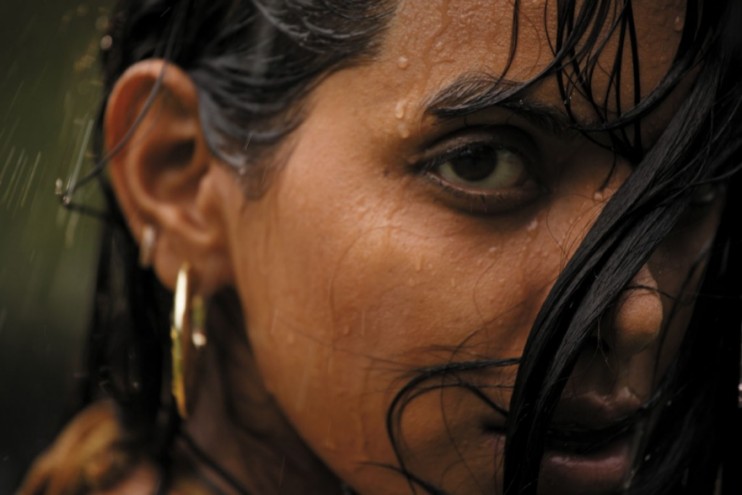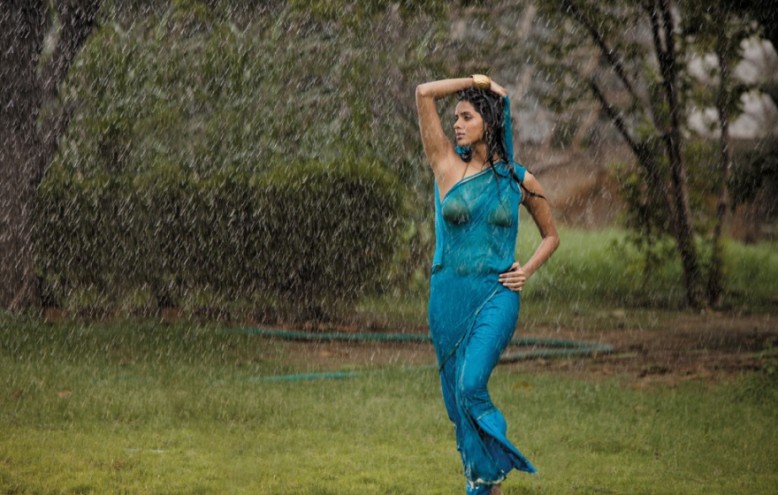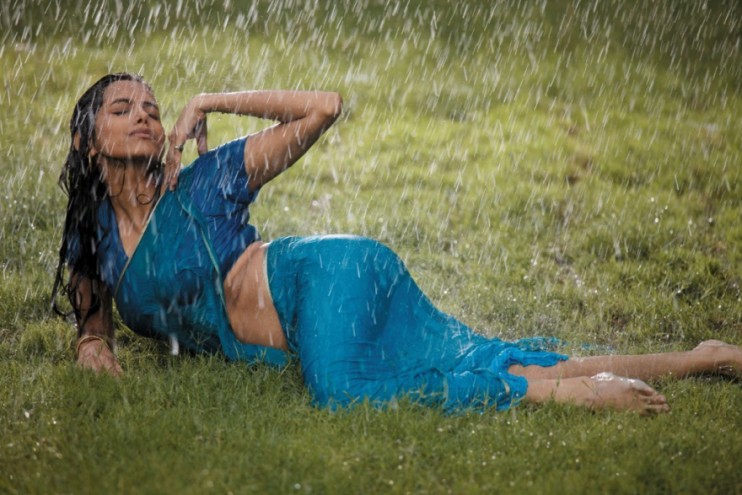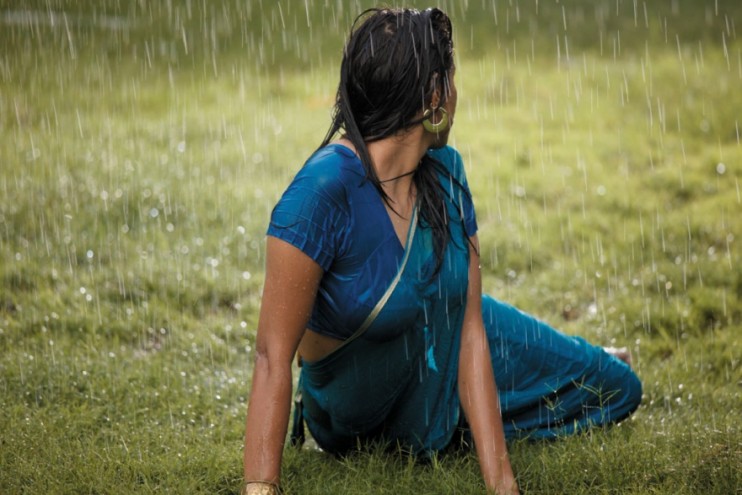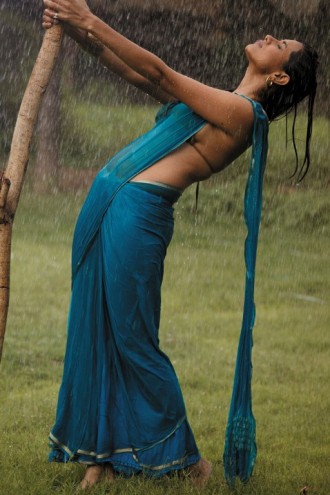First Published in
Ask Bollywood, where the sari – especially of the coquettish song and dance rain scenes – has endured year after year, from Nargis’ demure wet sari duet in Shree 420 (1955), to the frolicking of Smita Patil and Amitabh Bachchan in Namak Halaal (1982) to Katrina Kaif in De Dana Dan (2009), whose prowess under the waterfall is only surpassed by her ability to change saris four times, during a song that lasts as many minutes.
If the sari did become rarer in corporate cubicles, it’s because it’s been quietly making a metamorphosis – from ethnic wear to glamour wear. Today’s chic power dresser knows that in a boardroom filled with regulation grey jackets and trousers, if you want to stand out rather than blend in, you’d put your money on that new fusion kalamkari (block-prints) on tussar (silk). Or Sonia Gandhi’s favourite ikkat, an indigenous weave. Or the summer favourites, digital-print and monochrome chiffon saris.
No doubt fewer women are wearing saris nowadays, and less frequently as well. Convenience is winning over elegance – and oomph – as more and more women give up on the six yards and turn to the Punjabi salwar-kameez (pants and tunic). In cities and towns, jeans and trousers are everywhere. But that’s precisely why the sari is so hot – and cool: it lets you stand out, effortlessly.
Jeans and skirts are for those with the genes and the means to keep their bodies looking 18 till they die. But the sari does great things for the female figure – it makes you look like you’re in good shape without looking like you spend most of your time getting into it. It is inconvenient? Only for the lazy and the gauche. Just dig into your old family albums and you’ll find your granny cycling to college in a sari. Every day. That’s not something most young women do today, but the sari is de rigueur at the Indian equivalent of the prom, the high school or college farewell. As it is at weddings and official functions. TV soaps, over the top and insipid as they may be, will alone keep the sari from going the kimono way.
So while traditional weavers may justifiably rue the passing into history of patrons who could appreciate exquisite, lovingly plaited warps and woofs, a new crop of market-savvy weavers and designers are ready for the change. Every designer worth their picture on Page Three has a signature line that flies off the shelves during wedding season. For daily wear too, there’s no dearth of trendier weaves and designs to spike your wardrobe with a dash of va va voom.
So skip those Balmain and Valentino two-pieces and get yourself into a Jamdani – the sensuous fine muslin sari. The sari is, and will remain, the Indian little black dress.
It is very important to wear a perfectly fitted blouse under your sari. V-neck, basket neck, wide neck, sweetheart neck, boat neck, round neck, deep u-neck – the shapes are many, and you can choose the one that best suits your body and the occasion.
1. Put on the undergarments – the blouse and petticoat (slip skirt) – and unfold the sari. Be sure to handle the sari delicately as it can wrinkle easily.
2. Take hold of the sari and wrap the length of the fabric once around your waist. Secure and adjust the length by tucking the extra fabric into your petticoat. You are now ready to pleat the rest of the sari.
3. Hold the sari tight with your left hand and start making the pleats with your right.
4. The correct way of pleating is by weaving the fabric between the thumb and middle finger, while the rest of the hand holds the pleats together as they are made.
5. The numbers of pleats may vary according to style and taste, but in most cases it is advisable to make between five and seven folds.
6. Once your sari is uniformly pleated, level the height of the folds and tuck them neatly inside your petticoat, then adjust them to make sure they are straight and slightly fanned at the bottom – according to what you like best.
7. Wrap the remaining length of fabric around your waist, pass it under your right arm and bring it up to your left shoulder; the fabric should now cover the portion of your body between your bust and knees.
8. Make sure the sari is quite tight around your hips, waist and chest and adjust it on your left arm, covering more or less of it according to your preference. Finally admire yourself in the beauty of the sari, a garment that has no match in the realm of fashion.
If someone tells you the sari is back, don’t believe them. It never went away in the first place.
Ask Bollywood, where the sari – especially of the coquettish song and dance rain scenes – has endured year after year, from Nargis’ demure wet sari duet in Shree 420 (1955), to the frolicking of Smita Patil and Amitabh Bachchan in Namak Halaal (1982) to Katrina Kaif in De Dana Dan (2009), whose prowess under the waterfall is only surpassed by her ability to change saris four times, during a song that lasts as many minutes.
If the sari did become rarer in corporate cubicles, it’s because it’s been quietly making a metamorphosis – from ethnic wear to glamour wear. Today’s chic power dresser knows that in a boardroom filled with regulation grey jackets and trousers, if you want to stand out rather than blend in, you’d put your money on that new fusion kalamkari (block-prints) on tussar (silk). Or Sonia Gandhi’s favourite ikkat, an indigenous weave. Or the summer favourites, digital-print and monochrome chiffon saris.
No doubt fewer women are wearing saris nowadays, and less frequently as well. Convenience is winning over elegance – and oomph – as more and more women give up on the six yards and turn to the Punjabi salwar-kameez (pants and tunic). In cities and towns, jeans and trousers are everywhere. But that’s precisely why the sari is so hot – and cool: it lets you stand out, effortlessly.
Jeans and skirts are for those with the genes and the means to keep their bodies looking 18 till they die. But the sari does great things for the female figure – it makes you look like you’re in good shape without looking like you spend most of your time getting into it. It is inconvenient? Only for the lazy and the gauche. Just dig into your old family albums and you’ll find your granny cycling to college in a sari. Every day. That’s not something most young women do today, but the sari is de rigueur at the Indian equivalent of the prom, the high school or college farewell. As it is at weddings and official functions. TV soaps, over the top and insipid as they may be, will alone keep the sari from going the kimono way.
So while traditional weavers may justifiably rue the passing into history of patrons who could appreciate exquisite, lovingly plaited warps and woofs, a new crop of market-savvy weavers and designers are ready for the change. Every designer worth their picture on Page Three has a signature line that flies off the shelves during wedding season. For daily wear too, there’s no dearth of trendier weaves and designs to spike your wardrobe with a dash of va va voom.
So skip those Balmain and Valentino two-pieces and get yourself into a Jamdani – the sensuous fine muslin sari. The sari is, and will remain, the Indian little black dress.
It is very important to wear a perfectly fitted blouse under your sari. V-neck, basket neck, wide neck, sweetheart neck, boat neck, round neck, deep u-neck – the shapes are many, and you can choose the one that best suits your body and the occasion.
1. Put on the undergarments – the blouse and petticoat (slip skirt) – and unfold the sari. Be sure to handle the sari delicately as it can wrinkle easily.
2. Take hold of the sari and wrap the length of the fabric once around your waist. Secure and adjust the length by tucking the extra fabric into your petticoat. You are now ready to pleat the rest of the sari.
3. Hold the sari tight with your left hand and start making the pleats with your right.
4. The correct way of pleating is by weaving the fabric between the thumb and middle finger, while the rest of the hand holds the pleats together as they are made.
5. The numbers of pleats may vary according to style and taste, but in most cases it is advisable to make between five and seven folds.
6. Once your sari is uniformly pleated, level the height of the folds and tuck them neatly inside your petticoat, then adjust them to make sure they are straight and slightly fanned at the bottom – according to what you like best.
7. Wrap the remaining length of fabric around your waist, pass it under your right arm and bring it up to your left shoulder; the fabric should now cover the portion of your body between your bust and knees.
8. Make sure the sari is quite tight around your hips, waist and chest and adjust it on your left arm, covering more or less of it according to your preference. Finally admire yourself in the beauty of the sari, a garment that has no match in the realm of fashion.

